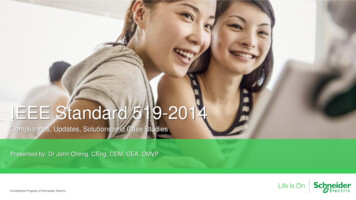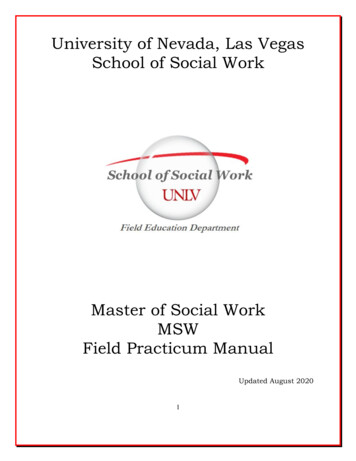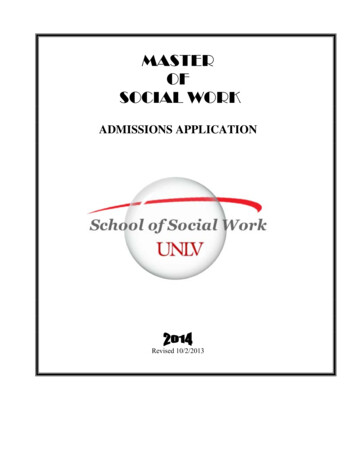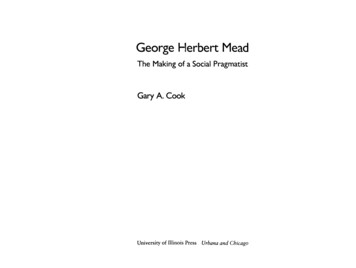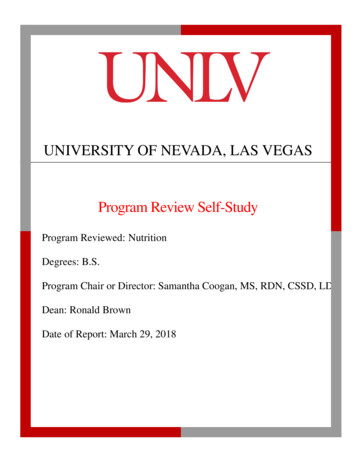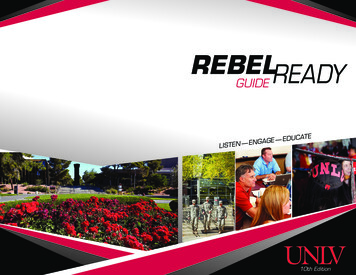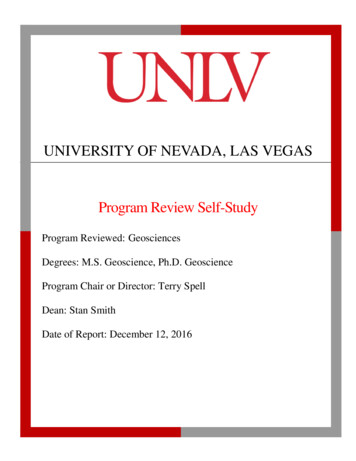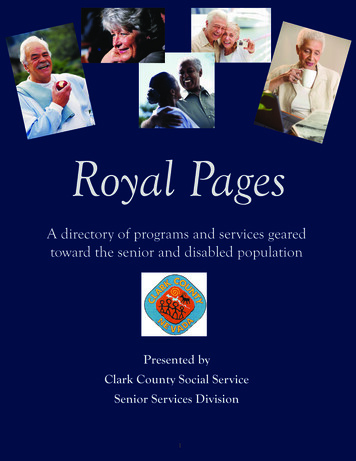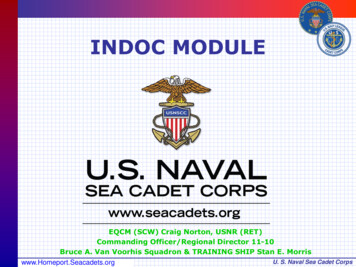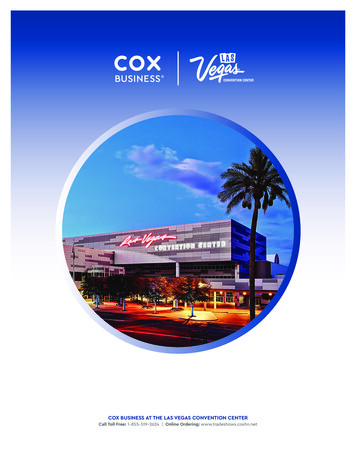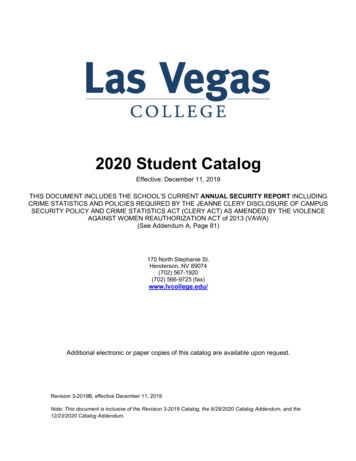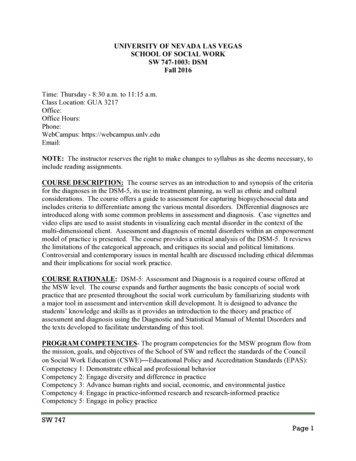
Transcription
UNIVERSITY OF NEVADA LAS VEGASSCHOOL OF SOCIAL WORKSW 747-1003: DSMFall 2016Time: Thursday - 8:30 a.m. to 11:15 a.m.Class Location: GUA 3217Office:Office Hours:Phone:WebCampus: https://webcampus.unlv.eduEmail:NOTE: The instructor reserves the right to make changes to syllabus as she deems necessary, toinclude reading assignments.COURSE DESCRIPTION: The course serves as an introduction to and synopsis of the criteriafor the diagnoses in the DSM-5, its use in treatment planning, as well as ethnic and culturalconsiderations. The course offers a guide to assessment for capturing biopsychosocial data andincludes criteria to differentiate among the various mental disorders. Differential diagnoses areintroduced along with some common problems in assessment and diagnosis. Case vignettes andvideo clips are used to assist students in visualizing each mental disorder in the context of themulti-dimensional client. Assessment and diagnosis of mental disorders within an empowermentmodel of practice is presented. The course provides a critical analysis of the DSM-5. It reviewsthe limitations of the categorical approach, and critiques its social and political limitations.Controversial and contemporary issues in mental health are discussed including ethical dilemmasand their implications for social work practice.COURSE RATIONALE: DSM-5: Assessment and Diagnosis is a required course offered atthe MSW level. The course expands and further augments the basic concepts of social workpractice that are presented throughout the social work curriculum by familiarizing students witha major tool in assessment and intervention skill development. It is designed to advance thestudents’ knowledge and skills as it provides an introduction to the theory and practice ofassessment and diagnosis using the Diagnostic and Statistical Manual of Mental Disorders andthe texts developed to facilitate understanding of this tool.PROGRAM COMPETENCIES- The program competencies for the MSW program flow fromthe mission, goals, and objectives of the School of SW and reflect the standards of the Councilon Social Work Education (CSWE)—Educational Policy and Accreditation Standards (EPAS):Competency 1: Demonstrate ethical and professional behaviorCompetency 2: Engage diversity and difference in practiceCompetency 3: Advance human rights and social, economic, and environmental justiceCompetency 4: Engage in practice-informed research and research-informed practiceCompetency 5: Engage in policy practiceSW 747Page 1
Competency 6: Engage with individuals, families, groups, organizations, and communitiesCompetency 7: Assess individuals, families, groups, organizations, and communitiesCompetency 8: Intervene with individuals, families, groups, organizations, and communitiesCompetency 9: Evaluate practice with individuals, families, groups, organizations, andcommunities.COURSE COMPETENCIES AND PRACTICE BEHAVIORS:In the direct practice concentration course competencies place an emphasis on Competencies 1 and7. The course material, instruction, and assignments will allow students the opportunity to achievethe following competencies:Competency 1: Demonstrate ethical and professional behavior.Practice behavior: Use supervision and consultation to guide professional judgment andbehavior.Measurement: Participation in class discussions and case assessments.Competency 7: Assess individuals, families, groups, organizations, and communitiesPractice behavior: Collect and organize data, and apply critical thinking to interpretinformation from clients and constituencies.Measurement: Video assignments, weekly tests, in-class case assessments, and finalexam.Practice behavior: Apply knowledge of human behavior and the social environment,person-in-environment, and other multidisciplinary theoretical frameworks in the analysisof assessment data from clients and constituencies.Measurement: Video assignments, weekly tests, in-class case assessments, and finalexam.COURSE OBJECTIVES:Objective 1MeasureObjective 2MeasureObjective 3MeasureObjective 4MeasureObjective 5MeasureDescribe the historical background, nature, and purpose of the DSM-5 incontemporary social work practice.Class discussionsApply appropriate ethnic and cultural considerations to effectively utilizediagnostic and assessment procedures for client empowerment and advocacy.Class discussions, tests, brief assessments, and diagnostic evaluationDemonstrate a working knowledge of the DSM and its relevance to SW practice.Class discussions, tests, brief assessments, and diagnostic evaluationDemonstrate diagnostic skill in assessments.Class discussions, tests, brief assessments, and diagnostic evaluationExamine the controversial and contemporary practice, policy, and ethical issuesinherent in the DSM-5 and the mental health field.Class discussions and testsPREREQUISITES: SW 720 and SW 730.SW 747Page 2
COURSE REQUIREMENTS AND CRITERIA FOR GRADING:I.Attendance and Participation - 10%Active participation is expected in this course and is considered a part of professional behavior,and therefore is always important in professional education. Obviously, participation cannotoccur without full attendance in the course. Students are expected to fully prepare for class toinclude completing all reading and/or outside assignments. More than two unexcusedabsences will result in a failing grade. Although the use of technology makes life moreconvenient, it also can be a distraction in class, therefore students who text in class will beconsidered absent. Please put your cell phones away.II.In-class tests: 10 pts each x 12 120 pts – 50%III.Supplemental videos: 10 pts each x 9 90 pts – 20%Select one from each of the nine groups of assigned videos (total 9) and utilize the DSM5 to place the client’s behavior within the symptom clusters utilizing a brief assessmentformat. Email to instructor NLT than Sunday evening the week they are assigned.IV.Diagnostic Evaluation– 20%Due: Dec 8 in classGRADING SCALEA 100 - 94A 93 - 90B 89 - 87B 86 - 83B 82 - 80C 79 - 77CCD DDF 76 - 7372 - 7069 - 6766 - 6362 - 60 60UNLV POLICIESAcademic Misconduct—Academic integrity is a legitimate concern for every member of thecampus community; all share in upholding the fundamental values of honesty, trust, respect,fairness, responsibility and professionalism. By choosing to join the UNLV community, studentsaccept the expectations of the Student Academic Misconduct Policy and are encouraged whenfaced with choices to always take the ethical path. Students enrolling in UNLV assume theobligation to conduct themselves in a manner compatible with UNLV’s function as aneducational institution. An example of academic misconduct is plagiarism. Plagiarism is usingthe words or ideas of another, from the Internet or any source, without proper citation of thesources. See the Student Academic Misconduct Policy (approved December 9, 2005) located duct.There is to be no use of laptops, cell phones, or any other audio/visual/electronictechnologies by students during class periods without specific approval by the instructor.Also, per NSHE policy, there is to be no audio/videotaping in the classroom withoutSW 747Page 3
instructor approval or accommodations determined by the Disability Resource Center.Copyright—The University requires all members of the University Community to familiarizethemselves with and to follow copyright and fair use requirements. You are individually andsolely responsible for violations of copyright and fair use laws. The university will neitherprotect nor defend you nor assume any responsibility for employee or student violations offair use laws. Violations of copyright laws could subject you to federal and state civil penaltiesand criminal liability, as well as disciplinary action under University policies. Additionalinformation can be found at: http://www.unlv.edu/provost/copyright.Disability Resource Center (DRC)—The UNLV Disability Resource Center (SSC-A 143,http://drc.unlv.edu/, #702-895-0866) provides resources for students with disabilities. If you feelthat you have a disability, please make an appointment with a Disabilities Specialist at the DRCto discuss what options may be available to you. If you are registered with the UNLV DisabilityResource Center, bring your Academic Accommodation Plan from the DRC to the instructorduring office hours so that you may work together to develop strategies for implementing theaccommodations to meet both your needs and the requirements of the course. Any informationyou provide is private and will be treated as such. To maintain the confidentiality of yourrequest, please do not approach the instructor in front of others to discuss your accommodationneeds.Religious Holidays Policy—Any student missing class quizzes, examinations, or any other class or lab workbecause of observance of religious holidays shall be given an opportunity during that semester to make up missedwork. The make-up will apply to the religious holiday absence only. It shall be the responsibility of the student to notifythe instructor within the first 14 calendar days of the course for fall and spring courses (excepting modular courses), orwithin the first 7 calendar days of the course for summer and modular courses, of his or her intention to participate inreligious holidays which do not fall on state holidays or periods of class recess. For additional information, pleasevisit: http://catalog.unlv.edu/content.php?catoid 6&navoid 531.Transparency in Learning and Teaching—The University encourages application of the transparency method ofconstructing assignments for student success. Please see these two links for further yIncomplete Grades—The grade of I—Incomplete—can be granted when a student hassatisfactorily completed three-fourths of course work for that semester/session but for reason(s)beyond the student’s control, and acceptable to the instructor, cannot complete the last part of thecourse, and the instructor believes that the student can finish the course without repeating it. Theincomplete work must be made up before the end of the following regular semester forundergraduate courses. Graduate students receiving “I” grades in 500-, 600-, or 700-levelcourses have up to one calendar year to complete the work, at the discretion of the instructor. Ifcourse requirements are not completed within the time indicated, a grade of F will be recordedand the GPA will be adjusted accordingly. Students who are fulfilling an Incomplete do notregister for the course but make individual arrangements with the instructor who assigned the “I”grade.SW 747Page 4
Tutoring and Coaching—The Academic Success Center (ASC) provides tutoring, academicsuccess coaching and other academic assistance for all UNLV undergraduate students. Forinformation regarding tutoring subjects, tutoring times, and other ASC programs and services,visit http://www.unlv.edu/asc or call 702-895-3177. The ASC building is located across from theStudent Services Complex (SSC). Academic success coaching is located on the second floor ofthe SSC (ASC Coaching Spot). Drop-in tutoring is located on the second floor of the LiedLibrary and College of Engineering TEB second floor.UNLV Writing Center—One-on-one or small group assistance with writing is available free ofcharge to UNLV students at the Writing Center, located in CDC-3-301. Although walk-inconsultations are sometimes available, students with appointments will receive priorityassistance. Appointments may be made in person or by calling 702-895-3908. The student’sRebel ID Card, a copy of the assignment (if possible), and two copies of any writing to bereviewed are requested for the consultation. More information can be found at:http://writingcenter.unlv.edu/.Rebelmail—By policy, faculty and staff should e-mail students’ Rebelmail accounts only.Rebelmail is UNLV’s official e-mail system for students. It is one of the primary ways studentsreceive official university communication such as information about deadlines, major campusevents, and announcements. All UNLV students receive a Rebelmail account after they havebeen admitted to the university. Students’ e-mail prefixes are listed on class rosters. The suffix isalways @unlv.nevada.edu. Emailing within WebCampus is acceptable.Final Examinations—The University requires that final exams given at the end of a courseoccur at the time and on the day specified in the final exam schedule. See the schedule ISM - Proper credit must be given to others’ ideas. They must be cited within the text(author(s) and page #’s) and in the references on a separate page at the end of the assignment(see Publication Manual of the American Psychological Association, 4th edition). Direct quotesmust begin and end with quotation marks. Plagiarism will result in a failing grade.ETHICAL GUIDELINES AND PROFESSIONAL BEHAVIOR - Professional social workeducation is an opportunity to learn, practice, and teach the professional principles necessary forethical social work practice. You are expected to be on time for class; come prepared; exercisecourtesy and respect towards your classmates. You are expected to engage in respectful andthoughtful discussions in class, deepening and broadening your repertoire of knowledge andskills in the interaction with others with different perspectives. Although our discussionsnecessarily involve our own experiences, please remember that the class situation is not aprofessional setting in regard to confidentiality. If you or someone you know requires assistanceor counseling, please contact an appropriate agency, or for referral, contact the social work office#702-895-3311, or my office, #702-895-5142.Consensual Relationships – UNLV prohibits romantic or sexual relationships betweenmembers of the university community when one of the individuals involved has directprofessional influence or direct authority over the other. For further information, seehttp://hr.unlv.edu/policies/consensual.html.SW 747Page 5
REQUIRED TEXTBOOK:American Psychiatric Association. (2013). Diagnostic and statistical manual of mental disorders(DSM-5) (5th ed.) Arlington, VA: American Psychiatric Publishing, Inc., 2013.SUPPLEMENTAL READINGS (found on WebCampus)COURSE SCHEDULE:WEEKDATE1Sept 12Sep 8READINGS (Instructor reserves the right to change, however students willbe notified of any adjustments)Introductions; Course Overview and Syllabus ReviewDSM-5: Overview & HistoryWhy Diagnose?Readings: Text:o DSM-5, Highlights of Changes from DSM-IV to DSM-5, pp.809 - 816 Supplemental:O Cooper, R. (2015). Must disorders cause harm? The changingstance of the DSM.O Understanding ICD-10-CM and DSM-5: A quick guide forpsychiatrists and other mental health clinicians. AmericanPsychiatric Association.Video: Just eaker: Dr. Allison WerlingerNeurodevelopmental Disorders (Intellectual Disabilities, AutismSpectrum Disorder, ADD/ADHD)Introduction to DC: 0 – 3R (Diagnostic Classification of Mental Health)Readings: Text:o DSM-5, Neurodevelopmental Disorders, pp. 31 – 86. Supplemental Readingo Hallowell, E.M. & Ratey, J.J. Delivered from Distraction –Chapt yId 4749307o Paris, J. (2015). The intelligent clinician’s guide to the DSM-5(2nd Ed). Cary, NC: Oxford University Press§ Chapt 13, Neurodevelopmental & disruptive Doso Attention deficit disorder: Old questions, new answers. HarvardSW 747Page 6
Mental Health Letter [Feb 2006]o Recognizing and managing ADHD in adults. Harvard MentalHealth Letter [Nov 2009]o Autism spectrum disorders revisited. Harvard Mental HealthLetter [Oct 2011]Test: # 13Sep 15Schizophrenia Spectrum and Other Psychotic Disorders(Delusional Disorder, Schizoaffective, Schizophreniform, Schizophrenia)Readings: Text:o DSM-5, Schizophrenia Spectrum & Other Psychotic D/o, pp.87 – 123. Supplemental Readingo Paris, J. (2015). The intelligent clinician’s guide to the DSM-5(2nd Ed). Cary, NC: Oxford University Press§ Chapt 8, Schizophrenia Spectrumo Understanding the risks of antipsychotic treatment in youngpeople. Harvard Mental Health Letter [Mar 2009]Videos: Schizophreniao Adult schizophreniao Schizophrenic on a bad dayhttps://www.youtube.com/watch?v 5LCtV1 TgiMo My journey with schizoaffective disorderhttps://www.youtube.com/watch?v KIfw-ljOQGgo Childhood schizophreniao Meet "Seven" Born Schizophrenichttps://www.youtube.com/watch?v vYQ6pbJt2k Schizophrenic Kidshttps://www.youtube.com/watch?v PVHNGZ0Omx0Assignment 1: Select one of the videos and utilize the DSM-5 to place theclient’s behavior within the symptom clusters. DSM 5 Guided Collection, Vol. 3http://unlv.kanopystreaming.com/node/118303o Schizophrenia and Other Psychotic Disorderso Schizophrenia (with delusions, disorganized speech ofderailment type, and negative symptoms of diminishedemotional expression)o Delusional Disorder – Mixed Subtypeo Delusional Disorder – Persecutory Subtypeo Delusional Disorder – Somatic Subtypeo Delusional Disorder – Erotomanic Subtypeo Delusional Disorder – Jealous SubtypeSW 747Page 7
o Brief Psychotic DisorderTest: # 2Extra credit: Submit a response paper to the video Schizophrenia: Stolen minds,Stolen liveshttp://youtu.be/Rv0b1unxUpM4Sep 22Depressive Disorders (Disruptive Mood Dysregulation, MajorDepression, Persistent Depressive Mood Disorder, PremenstrualDysphoria)Readings: Text:o DSM-5, Depressive Disorders, pp. 155 – 188. Supplemental Readingo Paris, J. (2015). The intelligent clinician’s guide to the DSM-5(2nd Ed). Cary, NC: Oxford University Press§ Chapt 10, Depressive disorderso Antidepressants and suicide. Harvard Mental Health Letter [Jul2007]o Recognizing depression in men. Harvard Mental Health Letter[Jun 2011]o Wakefield, J.C. (2015). The loss of grief: Science andpseudoscience in the debate over DSM-5’s elimination of thebereavement exclusion.Videos: Depression The Misunderstood Epidemichttps://www.youtube.com/watch?v 5cpzlN1Sf9E Rethinking How We Understand and Treat Depression: CharlesRaison at TEDxTucsonSalonhttps://www.youtube.com/watch?v hDvAsp3ySEoAssignment 2: Select one of the videos and utilize the DSM-5 to place theclient’s behavior within the symptom clusters. DSM 5 Guided Collection, Vol. 4http://unlv.kanopystreaming.com/node/118305o Major Depressive Disorder with Anxious Distresso Major Depressive Disorder with Melancholic Featureso Major Depressive Disorder with Peripartum Onseto Major Depressive Disorder with Seasonal PatternTest: #3Extra credit:SW 747Page 8
5Sep 29Watch the video The Truth About Depression and write a responsepaperhttps://www.youtube.com/watch?v hNRjFz0oH6oBipolar Disorders (Bipolar I, Bipolar II, Cyclothymia)Readings: Text:o DSM-5, Bipolar & Related Disorders, pp. 123 – 155 Supplemental Readingo Paris, J. (2015). The intelligent clinician’s guide to the DSM-5(2nd Ed). Cary, NC: Oxford University Press§ Chapt 9, Bipolar disordero Bipolar disorder in children. Harvard Mental Health Letter[May 2007]Video: TEDxTerryTalks - Laura Bain - Living with Bipolar Type IIhttps://www.youtube.com/watch?v 8Ki9dgG3P5MSpeaker: Dr. Howard Roitman6Oct 6Test: # 4Assignment 3: Select one of the videos and utilize the DSM-5 to place theclient’s behavior within the symptom clusters. DSM 5 Guided Collection, Vol. 4http://unlv.kanopystreaming.com/node/118305o Bipolar I Disorder with Mood-Congruent Psychotic Featureso Bipolar I Disorder with Mood-Congruent Psychotic FeaturesAfter TreatmentAnxiety Disorders (Separation Anxiety, Specific Phobia, Social Anxiety,Panic, Agoraphobia)Readings: Text:o DSM-5, Anxiety Disorders, pp. 189 – 233. Supplemental Readingo Paris, J. (2015). The intelligent clinician’s guide to the DSM-5(2nd Ed).
PROGRAM COMPETENCIES- The program competencies for the MSW program flow from the mission, goals, and objectives of the School of SW and reflect the standards of the Council . UNLV Writing Center—One-on-one or small group assistance with writing is available free of charge to UNLV

